The fluidized conveying equipment market is projected to grow from USD 2,084.1 million in 2025 to USD 3,084.9 million in 2035, reflecting a CAGR of 4.0%. A peak-to-trough analysis highlights periods of acceleration and relative stabilization in market growth, reflecting industry adoption patterns and operational cycles. From 2025 to 2028, the fluidized conveying equipment market is expected to reach an initial peak driven by demand from bulk material handling in chemicals, pharmaceuticals, food processing, and minerals. Increased investments in automated systems and efficiency-driven solutions contribute to this early-stage expansion, with manufacturers focusing on high-performance, low-maintenance equipment.
A trough phase may occur between 2028 and 2031 as adoption stabilizes in mature regions and replacement cycles slow. During this period, growth remains positive but moderate, influenced by temporary adjustments in production schedules, economic fluctuations, or project delays in end-use industries. From 2031 to 2035, the fluidized conveying equipment market is anticipated to recover and accelerate as emerging economies expand industrial infrastructure and technology upgrades in existing facilities drive renewed demand. The peak-to-trough analysis illustrates a pattern of steady growth punctuated by periods of moderate stabilization. The fluidized conveying equipment market demonstrates resilience, with early peaks fueled by investment surges and troughs reflecting short-term adjustments, while long-term expansion remains intact.
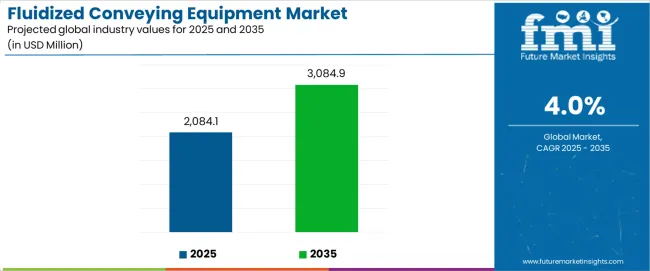
| Period | Primary Revenue Buckets | Share | Notes |
|---|---|---|---|
| Today | Cement industry applications (kilns, storage, transport) | 42% | Traditional bulk handling, established plants |
| Chemical processing systems | 28% | Powder handling, pharmaceutical applications | |
| Power generation equipment | 18% | Coal handling, ash transport systems | |
| Mining and metals operations | 12% | Ore processing, mineral transport | |
| Future (3-5 yrs) | Advanced cement systems | 35-38% | Smart conveying, emission control |
| Chemical & pharmaceutical | 25-28% | Precision handling, contamination control | |
| Power & energy applications | 20-23% | Biomass handling, waste-to-energy | |
| Mining automation | 15-18% | Intelligent transport, safety systems | |
| Food processing | 8-12% | Hygienic conveying, quality control | |
| Specialty applications | 4-7% | Custom solutions, niche industries |
At-a-Glance Metrics
| Metric | Value |
|---|---|
| Market Value (2025) | USD 2,084.1 million |
| Market Forecast (2035) | USD 3,084.9 million |
| Growth Rate | 4.0% CAGR |
| Leading Capacity Range | 200-400 TPH Systems |
| Primary Application | Cement Industry Segment |
The fluidized conveying equipment market demonstrates strong fundamentals with 200-400 TPH capacity systems capturing a dominant share through advanced conveying capabilities and industrial application optimization. Cement industry applications drive primary demand, supported by increasing automation requirements and industrial facility modernization initiatives. Geographic expansion remains concentrated in developed markets with established industrial infrastructure, while emerging economies show accelerating adoption rates driven by manufacturing modernization initiatives and rising efficiency standards.
Primary Classification: The fluidized conveying equipment market segments by capacity range into Below 200 TPH, 200-400 TPH, and 400+ TPH, representing the evolution from small-scale operations to high-capacity industrial conveying systems for comprehensive material handling optimization.
Secondary Classification: Application segmentation divides the fluidized conveying equipment market into cement industry, chemical industry, power generation, mining and metals, food and beverages, and others, reflecting distinct requirements for conveying performance, capacity standards, and material handling specifications.
Tertiary Classification: End-use segmentation covers manufacturing plants, processing facilities, power stations, mining operations, and construction projects, while distribution channels span direct sales, equipment distributors, and specialized industrial suppliers.
Regional Classification: Geographic distribution covers North America, Latin America, Western Europe, Eastern Europe, East Asia, South Asia Pacific, and Middle East & Africa, with developed markets leading adoption while emerging economies show accelerating growth patterns driven by industrial modernization programs.
The segmentation structure reveals capacity progression from traditional small-scale systems toward high-capacity automated conveying solutions with enhanced performance capabilities, while application diversity spans from cement manufacturing to specialized chemical processing requiring precision material handling solutions.
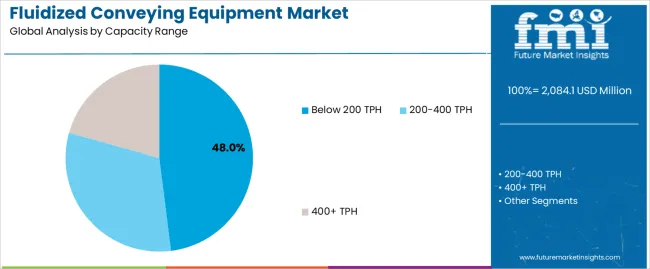
Market Position: 200-400 TPH conveying systems command the leading position in the fluidized conveying equipment market with 48% market share through proven capacity technologies, including efficient material flow, optimal throughput optimization, and industrial application compatibility that enable manufacturing operators to achieve optimal material handling across diverse cement and chemical processing environments.
Value Drivers: The segment benefits from industrial preference for mid-capacity conveying systems that provide operational efficiency, reliable performance, and cost optimization without requiring oversized equipment infrastructure. Advanced capacity control features enable enhanced flow management, automated operation, and integration with existing industrial systems, where throughput performance and operational reliability represent critical manufacturing requirements.
Competitive Advantages: 200-400 TPH systems differentiate through proven capacity reliability, optimal size characteristics, and integration with established industrial management systems that enhance facility effectiveness while maintaining optimal operational standards suitable for diverse material handling applications.
Key market characteristics:
Below 200 TPH conveying systems maintain a 32% market position in the fluidized conveying equipment market due to their flexibility advantages and cost-effective positioning benefits. These systems appeal to facilities requiring efficient material handling solutions with moderate capacity profiles for specialized operations. Market growth is driven by small-scale industrial expansion, emphasizing precision conveying solutions and operational efficiency through optimized control designs.
400+ TPH systems capture 20% market share through large-scale industrial requirements in major cement plants, power generation facilities, and mining applications. These facilities demand high-capacity equipment capable of supporting intensive material handling operations while providing maximum throughput access and operational efficiency capabilities.
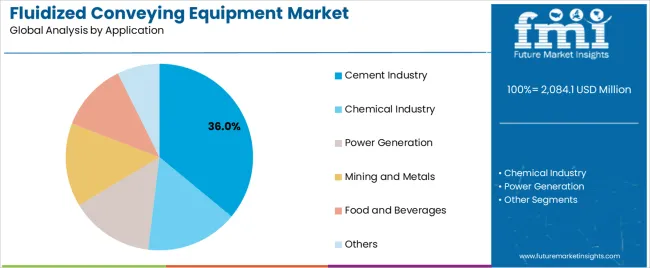
Market Context: Cement industry applications demonstrate strong growth in the fluidized conveying equipment market with 5.8% CAGR and 36% market share due to widespread adoption of automated material handling systems and increasing focus on production efficiency, operational cost reduction, and capacity optimization applications that maximize conveying effectiveness while maintaining quality standards.
Appeal Factors: Cement operators prioritize equipment reliability, consistent performance, and integration with existing production infrastructure that enables coordinated material flow operations across multiple processing stages. The segment benefits from substantial cement industry investment and modernization programs that emphasize the acquisition of advanced conveying equipment for production optimization and operational efficiency applications.
Growth Drivers: Cement expansion programs incorporate fluidized conveying as essential components for material handling operations, while infrastructure development increases demand for conveying capabilities that comply with production standards and minimize operational complexity.
Market Challenges: Varying production requirements and operational scale complexity may limit equipment standardization across different cement plants or processing scenarios.
Application dynamics include:
Chemical industry applications capture 28% market share through specialized handling requirements in pharmaceutical manufacturing, chemical processing, and industrial applications. These facilities demand precision conveying capable of supporting contamination control requirements while providing reliable material handling access and operational safety capabilities.
Power generation applications account for 18% market share, including coal handling systems, ash transport equipment, and biomass processing operations requiring performance conveying capabilities for efficiency optimization and environmental compliance.
Market Context: Manufacturing Plants dominate the fluidized conveying equipment market with 5.2% CAGR, reflecting the primary demand source for fluidized conveying technology in industrial applications and operational standardization.
Business Model Advantages: Manufacturing Plants provide direct market demand for standardized conveying systems, driving volume production and cost optimization while maintaining quality control and operational consistency requirements.
Operational Benefits: Manufacturing Plant applications include process standardization, efficiency optimization, and quality assurance that drive consistent demand for conveying systems while providing access to latest automation technologies.
| Category | Factor | Impact | Why It Matters |
|---|---|---|---|
| Driver | Industrial automation & manufacturing modernization (smart factories, Industry 4.0) | ★★★★★ | Growing industrial market requires automated conveying with enhanced efficiency capabilities and reliability properties proven effective across manufacturing applications. |
| Driver | Capacity optimization & operational efficiency (throughput improvement, cost reduction) | ★★★★★ | Transforms conveying requirements from "basic transport" to "intelligent material handling"; operators that offer advanced equipment and automation features gain competitive advantage. |
| Driver | Infrastructure development & construction growth (cement demand, power projects) | ★★★★☆ | Major construction projects need reliable, high-capacity conveying; demand for robust and efficient conveying solutions expanding addressable market. |
| Restraint | High capital costs & investment requirements (especially for small manufacturers) | ★★★★☆ | Smaller industrial operators defer equipment upgrades; increases price sensitivity and slows advanced conveying adoption in cost-conscious markets. |
| Restraint | Alternative conveying methods competition (belt conveyors, mechanical systems) | ★★★☆☆ | Traditional conveying alternatives offer established supply chains and lower costs, potentially limiting fluidized conveying adoption in traditional applications. |
| Trend | Automation technology integration & smart monitoring (IoT sensors, predictive maintenance) | ★★★★★ | Advanced automation capabilities, efficiency optimization, and performance analytics transform operations; technology integration and intelligent monitoring become core value propositions. |
| Trend | Environmental compliance & emission control (dust reduction, energy efficiency) | ★★★★☆ | Eco-friendly conveying for environmental compliance and sustainability; specialized designs and emission control capabilities drive competition toward environmental solutions. |
The fluidized conveying equipment market exhibits varied regional dynamics, with Growth Leaders including China (5.4% growth rate) and India (5.0% growth rate), driving expansion through industrial development initiatives and manufacturing modernization. Steady performers include Germany (4.6% growth rate) and Brazil (4.2% growth rate), as well as developed regions, which benefit from established industrial infrastructure and advanced adoption of conveying technology. Mature Markets feature the United States (3.8% growth rate), the United Kingdom (3.4% growth rate), and Japan (3.0% growth rate), where industrial advancement and automation requirements support consistent growth patterns.
Regional synthesis reveals East Asian markets leading adoption through manufacturing expansion and industrial development, while North American countries maintain steady expansion supported by automation technology advancement and operational standardization requirements. European markets show strong growth driven by industrial applications and efficiency integration trends.
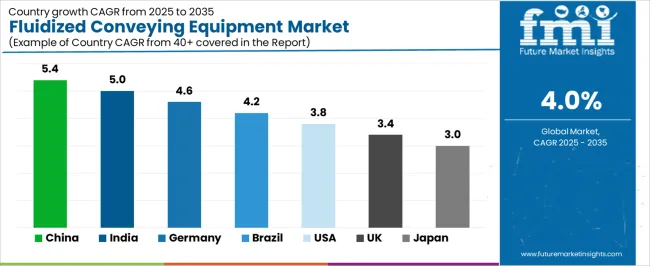
| Region/Country | 2025-2035 Growth | How to win | What to watch out |
|---|---|---|---|
| China | 5.4% | Focus on high-capacity manufacturing solutions | Regulatory changes; local competition |
| India | 5.0% | Lead with cost-effective industrial equipment | Import restrictions; infrastructure barriers |
| Germany | 4.6% | Provide premium automation systems | Over-regulation; lengthy approvals |
| Brazil | 4.2% | Offer value-oriented solutions | Currency fluctuations; import duties |
| United States | 3.8% | Push technology integration | Compliance costs; scaling challenges |
| United Kingdom | 3.4% | Focus on premium applications | Economic impacts; equipment costs |
| Japan | 3.0% | Emphasize precision manufacturing | Traditional preferences; adoption rates |
China establishes the fastest market growth through aggressive industrial development programs and comprehensive manufacturing expansion, integrating advanced fluidized conveying systems as standard components in cement facilities and chemical processing installations. The country's 5.4% growth rate reflects government initiatives that promote industrial infrastructure and domestic equipment capabilities, mandating the use of automated conveying systems in manufacturing and processing facilities. Growth concentrates in major industrial hubs, including Beijing, Shanghai, and Guangzhou, where manufacturing development showcases integrated conveying systems that appeal to industrial operators seeking capacity optimization capabilities and operational applications.
Chinese manufacturers are developing cost-effective conveying solutions that combine domestic production advantages with advanced automation features, including enhanced capacity control and improved efficiency capabilities. Distribution channels through industrial suppliers and equipment distributors expand market access, while government support for manufacturing development supports adoption across diverse cement and chemical processing segments.
Strategic Market Indicators:
In Mumbai, Delhi, and Bangalore, manufacturing facilities and industrial operators are implementing advanced fluidized conveying systems as standard equipment for material handling and operational optimization applications, driven by increasing government investment in industry and manufacturing modernization programs that emphasize the importance of automation capabilities. The fluidized conveying equipment market is projected to grow at a 5.0% rate, driven by government industrial initiatives and infrastructure development programs that promote the adoption of automated conveying systems in manufacturing and processing facilities. Indian operators are adopting conveying systems that offer consistent material handling performance and efficiency features, particularly in urban regions where operational excellence and capacity optimization are critical business requirements.
Market expansion benefits from growing industrial capabilities and international manufacturing partnerships that enable domestic production of automated conveying systems for cement and chemical applications. Technology adoption follows patterns established in industrial equipment, where reliability and efficiency drive procurement decisions and operational deployment.
Market Intelligence Brief:
Germany's advanced industrial market demonstrates sophisticated fluidized conveying deployment with documented efficiency effectiveness in manufacturing applications and processing facilities through integration with existing industrial systems and automation infrastructure. The country leverages engineering expertise in automation and quality systems integration to maintain a 4.6% growth rate. Industrial centers, including those in Bavaria, Baden-Württemberg, and North Rhine-Westphalia, feature premium installations where conveying systems seamlessly integrate with comprehensive manufacturing platforms and facility management systems to optimize material handling and operational efficiency.
German manufacturers prioritize system quality and EU compliance in conveying development, creating demand for premium systems with advanced features, including facility integration and automation systems. The fluidized conveying equipment market benefits from established industrial infrastructure and a willingness to invest in advanced conveying technologies that provide long-term operational benefits and compliance with international manufacturing standards.
Market Intelligence Brief:
Brazil's market expansion benefits from diverse industrial demand, including infrastructure development in Rio de Janeiro and São Paulo, manufacturing facility upgrades, and government industrial programs that increasingly incorporate advanced conveying solutions for material handling applications. The country maintains a 4.2% growth rate, driven by rising construction activity and increasing recognition of automated conveying benefits, including precise capacity control and enhanced operational effectiveness.
Market dynamics focus on cost-effective conveying solutions that balance operational performance with affordability considerations important to Brazilian industrial operators. Growing infrastructure industrialization creates continued demand for modern conveying systems in new manufacturing infrastructure and facility modernization projects.
Strategic Market Considerations:
United States establishes market leadership through comprehensive industrial programs and advanced manufacturing infrastructure development, integrating fluidized conveying systems across cement and chemical processing applications. The country's 3.8% growth rate reflects established industrial relationships and mature conveying technology adoption that supports widespread use of automated conveying systems in manufacturing and processing facilities. Growth concentrates in major industrial centers, including Texas, California, and the Midwest, where conveying technology showcases mature deployment that appeals to industrial operators seeking proven efficiency capabilities and operational optimization applications.
American industrial providers leverage established distribution networks and comprehensive technical support capabilities, including installation programs and training support that create customer relationships and operational advantages. The fluidized conveying equipment market benefits from mature regulatory standards and industrial requirements that mandate conveying system use while supporting technology advancement and operational optimization.
Market Intelligence Brief:
United Kingdom's industrial market demonstrates integrated fluidized conveying deployment with documented efficiency effectiveness in manufacturing applications and processing facilities through integration with existing industrial systems and automation infrastructure. The country maintains a 3.4% growth rate, supported by industrial excellence programs and efficiency requirements that promote automated conveying systems for manufacturing applications. Industrial facilities across England, Scotland, and Wales showcase systematic installations where conveying systems integrate with comprehensive manufacturing platforms to optimize material handling and operational outcomes.
UK industrial providers prioritize system reliability and industry compatibility in conveying procurement, creating demand for validated systems with proven efficiency features, including performance monitoring integration and automation systems. The fluidized conveying equipment market benefits from established industrial infrastructure and excellence requirements that support conveying technology adoption and operational effectiveness.
Market Intelligence Brief:
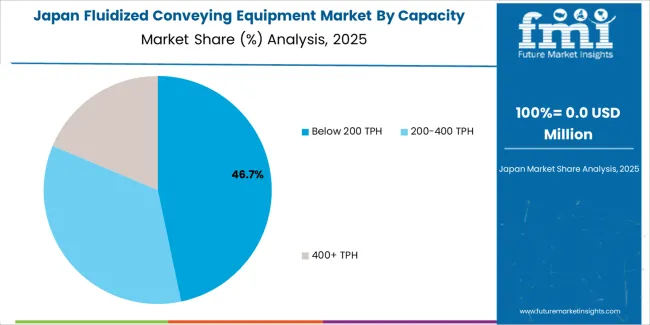
Japan's market growth benefits from precision industrial demand, including advanced manufacturing facilities in Tokyo and Osaka, quality integration, and efficiency enhancement programs that increasingly incorporate conveying solutions for material handling applications. The country maintains a 3.0% growth rate, driven by industrial technology advancement and increasing recognition of precision conveying benefits, including accurate capacity control and enhanced operational outcomes.
Market dynamics focus on high-precision conveying solutions that meet Japanese quality standards and efficiency requirements important to industrial operators. Advanced industrial technology adoption creates continued demand for sophisticated conveying systems in manufacturing facility infrastructure and operational modernization projects.
Strategic Market Considerations:
The European fluidized conveying equipment market is projected to grow from USD 426.2 million in 2025 to USD 631.8 million by 2035, registering a CAGR of 4.0% over the forecast period. Germany is expected to maintain its leadership position with a 41.8% market share in 2025, supported by its advanced industrial infrastructure and major manufacturing centers.
United Kingdom follows with a 22.3% share in 2025, driven by comprehensive industrial programs and manufacturing excellence development initiatives. France holds a 16.7% share through specialized industrial applications and manufacturing compliance requirements. Italy commands a 11.2% share, while Spain accounts for 5.8% in 2025. The rest of Europe region is anticipated to gain momentum, expanding its collective share from 2.2% to 2.8% by 2035, attributed to increasing industrial adoption in Nordic countries and emerging manufacturing facilities implementing industrial modernization programs.
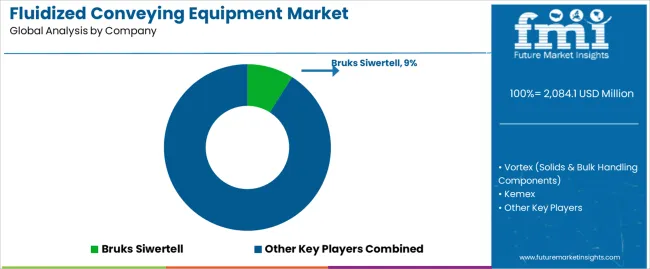
| Stakeholder | What they actually control | Typical strengths | Typical blind spots |
|---|---|---|---|
| Global brands | Distribution reach, broad product catalogs, brand recognition | Wide availability, proven reliability, multi-region support | Product refresh cycles; customer dependency on brand validation |
| Technology innovators | Automation R&D; advanced control technologies; enhanced performance capabilities | Latest technologies first; attractive ROI on efficiency effectiveness | Service density outside core regions; scaling complexity |
| Regional specialists | Local compliance, fast delivery, nearby customer support | "Close to customer" support; pragmatic pricing; local regulations | Technology gaps; talent retention in customer service |
| Full-service providers | Complete conveying programs, installation services, maintenance management | Lowest operational risk; comprehensive support | Service costs if overpromised; technology obsolescence |
| Niche specialists | Specialized applications, custom conveying, automation services | Win premium applications; flexible configurations | Scalability limitations; narrow market focus |
| Item | Value |
|---|---|
| Quantitative Units | USD 2,084.1 million |
| Capacity Range | Below 200 TPH, 200-400 TPH, 400+ TPH |
| Application | Cement Industry, Chemical Industry, Power Generation, Mining and Metals, Food and Beverages, Others |
| End Use | Manufacturing Plants, Processing Facilities, Power Stations, Mining Operations, Construction Projects |
| Regions Covered | North America, Latin America, Western Europe, Eastern Europe, East Asia, South Asia Pacific, Middle East & Africa |
| Countries Covered | China, India, Germany, Brazil, United States, United Kingdom, Japan, Canada, France, Australia, and 28+ additional countries |
| Key Companies Profiled | Bruks siwertell, Vortex, Kemex, Metso, Zeppelin Systems, Rieco Industries, Claudius Peters, Superoseiki, PEBCO |
| Additional Attributes | Dollar sales by capacity range and application categories, regional adoption trends across East Asia, North America, and Western Europe, competitive landscape with equipment manufacturers and automation suppliers, industrial operator preferences for conveying effectiveness and operational efficiency, integration with industrial platforms and automation systems, innovations in conveying technology and capacity enhancement, and development of advanced conveying solutions with enhanced performance and operational optimization capabilities. |
The global fluidized conveying equipment market is estimated to be valued at USD 2,084.1 million in 2025.
The market size for the fluidized conveying equipment market is projected to reach USD 3,084.9 million by 2035.
The fluidized conveying equipment market is expected to grow at a 4.0% CAGR between 2025 and 2035.
The key product types in fluidized conveying equipment market are below 200 tph, 200-400 tph and 400+ tph.
In terms of application, cement industry segment to command 36.0% share in the fluidized conveying equipment market in 2025.






Our Research Products

The "Full Research Suite" delivers actionable market intel, deep dives on markets or technologies, so clients act faster, cut risk, and unlock growth.

The Leaderboard benchmarks and ranks top vendors, classifying them as Established Leaders, Leading Challengers, or Disruptors & Challengers.

Locates where complements amplify value and substitutes erode it, forecasting net impact by horizon

We deliver granular, decision-grade intel: market sizing, 5-year forecasts, pricing, adoption, usage, revenue, and operational KPIs—plus competitor tracking, regulation, and value chains—across 60 countries broadly.

Spot the shifts before they hit your P&L. We track inflection points, adoption curves, pricing moves, and ecosystem plays to show where demand is heading, why it is changing, and what to do next across high-growth markets and disruptive tech

Real-time reads of user behavior. We track shifting priorities, perceptions of today’s and next-gen services, and provider experience, then pace how fast tech moves from trial to adoption, blending buyer, consumer, and channel inputs with social signals (#WhySwitch, #UX).

Partner with our analyst team to build a custom report designed around your business priorities. From analysing market trends to assessing competitors or crafting bespoke datasets, we tailor insights to your needs.
Supplier Intelligence
Discovery & Profiling
Capacity & Footprint
Performance & Risk
Compliance & Governance
Commercial Readiness
Who Supplies Whom
Scorecards & Shortlists
Playbooks & Docs
Category Intelligence
Definition & Scope
Demand & Use Cases
Cost Drivers
Market Structure
Supply Chain Map
Trade & Policy
Operating Norms
Deliverables
Buyer Intelligence
Account Basics
Spend & Scope
Procurement Model
Vendor Requirements
Terms & Policies
Entry Strategy
Pain Points & Triggers
Outputs
Pricing Analysis
Benchmarks
Trends
Should-Cost
Indexation
Landed Cost
Commercial Terms
Deliverables
Brand Analysis
Positioning & Value Prop
Share & Presence
Customer Evidence
Go-to-Market
Digital & Reputation
Compliance & Trust
KPIs & Gaps
Outputs
Full Research Suite comprises of:
Market outlook & trends analysis
Interviews & case studies
Strategic recommendations
Vendor profiles & capabilities analysis
5-year forecasts
8 regions and 60+ country-level data splits
Market segment data splits
12 months of continuous data updates
DELIVERED AS:
PDF EXCEL ONLINE
Conveying Equipment Market Size and Share Forecast Outlook 2025 to 2035
Fluidized Bed Dryer Market Size and Share Forecast Outlook 2025 to 2035
Equipment Management Software Market Size and Share Forecast Outlook 2025 to 2035
Equipment cases market Size and Share Forecast Outlook 2025 to 2035
Air Fluidized Therapy Beds Market Growth – Trends & Forecast 2025 to 2035
Farm Equipment Market Forecast and Outlook 2025 to 2035
Golf Equipment Market Size and Share Forecast Outlook 2025 to 2035
Port Equipment Market Size and Share Forecast Outlook 2025 to 2035
Pouch Equipment Market Growth – Demand, Trends & Outlook 2025 to 2035
Garage Equipment Market Forecast and Outlook 2025 to 2035
Mining Equipment Industry Analysis in Latin America Size and Share Forecast Outlook 2025 to 2035
Subsea Equipment Market Size and Share Forecast Outlook 2025 to 2035
Pavers Equipment Market Size and Share Forecast Outlook 2025 to 2035
Tennis Equipment Market Analysis - Size, Share, and Forecast Outlook 2025 to 2035
Galley Equipment Market Analysis and Forecast by Fit, Application, and Region through 2035
Sorting Equipment Market Size and Share Forecast Outlook 2025 to 2035
General Equipment Rental Services Market Size and Share Forecast Outlook 2025 to 2035
Bagging Equipment Market Size and Share Forecast Outlook 2025 to 2035
RF Test Equipment Market Size and Share Forecast Outlook 2025 to 2035
Medical Equipment Covers Market Size and Share Forecast Outlook 2025 to 2035

Thank you!
You will receive an email from our Business Development Manager. Please be sure to check your SPAM/JUNK folder too.
Chat With
MaRIA